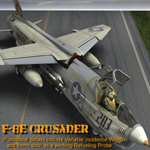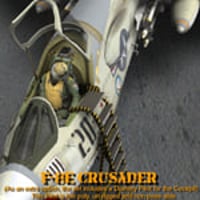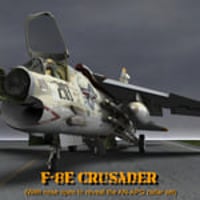-
65% OFF
-
-
-
You save $13.00$7.00$20.00
Artist:Compatible Software:Daz to Unity Bridge, Daz to Unreal Bridge, Poser, Daz to 3ds Max Bridge, Daz to C4D Bridge, Daz to Maya BridgeSKU:40233Optional License Add-Ons:
$35.00$1.99*Unless otherwise specified, no discounts or offers will apply to License Add‑Ons.
Artist: Digi-Mig VanishingPointCompatible Software: Poser, Daz to 3ds Max Bridge, Daz to C4D Bridge, Daz to Maya Bridge, Daz to Unity Bridge, Daz to Unreal BridgeSKU:40233Optional License Add-Ons:
$35.00$1.99*Unless otherwise specified, no discounts or offers will apply to License Add‑Ons.
-
Details
The Vought F-8 Crusader (originally F8U) was a single-engine, supersonic, carrier-based air superiority jet aircraft built by Vought for the United States Navy and Marine Corps, replacing the Vought F7U Cutlass, and for the French Navy. The first F-8 prototype was ready for flight in February 1955. The F-8 served principally in the Vietnam War. The Crusader was the last American fighter with guns as the primary weapon, earning it the title "The Last of the Gunfighters".
When conflict erupted in the skies over North Vietnam, it was U.S. Navy Crusaders from the USS Hancock that first tangled with Vietnam People`s Air Force (North Vietnamese Air Force) MiG-17s, on 3 April 1965. The MiGs claimed the downing of a Crusader, and one pilot`s gun camera revealed that his cannons had set an F-8 ablaze, but it was later found that the F-8 Pilot had managed to land his damaged Crusader at Da Nang, the remaining F-8s returning safely to their carrier.
At the time, the Crusader was the best dogfighter the United States had against the nimble North Vietnamese MiGs. The U.S. Navy had evolved its "night fighter" role in the air wing to an all-weather interceptor, the F-4 Phantom II, equipped to engage incoming bombers at long range with missiles such as AIM-7 Sparrow as their sole air-to-air weapons, and maneuverability was not emphasized in their design. Some experts believed that the era of the dogfight was over as air-to-air missiles would knock down adversaries well before they could get close enough to engage in dogfighting.
As aerial combat ensued over North Vietnam from 1965 to 1968, it became apparent that the dogfight was not over and the F-8 Crusader and a community trained to prevail in air-to-air combat was a key ingredient to success.
The Crusader also became a "bomb truck" in war, with both ship-based U.S. Navy units and land-based U.S. Marine Corps squadrons attacking communist forces in both North and South Vietnam. USMC Crusaders flew only in the south, while U.S. Navy Crusaders flew only from the small Essex-class carriers. Marine Crusaders also operated in close air support missions.
Despite the "last gunfighter" moniker, the F-8s achieved only four victories with their cannon; the remainder were accomplished with AIM-9 Sidewinder missiles, partly due to the propensity of the 20 mm (.79 in) Colt Mk 12 cannons` feeding mechanism to jam under G-loading during high-speed dogfighting maneuvers. Between June and July 1966, during 12 engagements over North Vietnam, Crusaders claim four MiG-17s for two losses.
The Crusader would claim the best kill ratio of any American type in the Vietnam War, 19:3. Of the 19 aircraft claimed during aerial combat, 16 were MiG-17s and three were MiG-21s. U.S. records only indicate 3 F-8s lost in aerial combat, all to MiG-17 cannon fire in 1966, but the NVAF claimed 11 F-8s were shot down by MiGs. A total of 170 F-8 Crusaders would be lost to all causes during the war.
LTV built and delivered the 1,219th (and last) U.S. Navy Crusader to VF-124 at NAS Miramar on 3 September 1964. The last active duty Navy Crusader fighter variants were retired from VF-191 and VF-194 aboard Oriskany in 1976 after almost two decades of service, setting a first for a Navy fighter.
The RF-8 Crusader was a photo-reconnaissance development and operated longer in U.S. service than any of the fighter versions. RF-8s played a crucial role in the Cuban Missile Crisis, providing essential low-level photographs impossible to acquire by other means. This variant continued to serve in the active duty Navy for yet another 11 years, with VFP-63 flying RF-8Gs up to 1982, and with the Naval Reserve flying their RF-8Gs in two squadrons (VFP-206 and VFP-306) at Naval Air Facility Washington / Andrews AFB until the disestablishment of VFP-306 in 1984 and VFP-206 on 29 March 1987 when the last operational Crusader was turned over to the National Air and Space Museum.What's Included and Features
naNotes
- This product includes:
- 1 Poser Core Installer
- This product includes:
You may also be interested in the following products
- 65% OFF$7.00 $20.00 You save $13.00
- 65% OFF
A7D/E Corsair II (for Poser)
A7D/E Corsair II (for Poser)
$7.00 $20.00 You save $13.00












